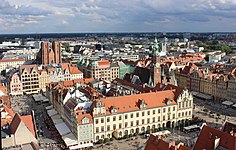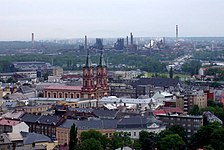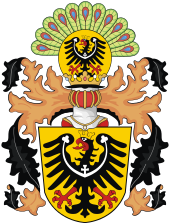Silesia
Silesian (Polish Śląsk; Czech Slezsko; German Schlesien; Silesian German dialect: Schläsing) is a historical region of Central Europe that is today almost entirely in Poland with small parts in the Czech Republic and Germany. Its regional coat of arms is a black eagle on a golden field.
In 990, Miecislaus I of Poland conquered this region from Boleslaus II of Bohemia. After having belonged to Poland, Silesia was annexed again to the Bohemian crown, then to Austria —which dominated Bohemia from 1526— and then to Prussia, from 1763 under the Treaty of Hubertusburg that put an end to the wars of Silesia.
The 19th century saw profound transformations in the region when coal was exploited, with the birth of large cities around the metal industry. After 1871, it was part of the unified Germany. The 20th century also brought great changes to the region, with Poland annexing a part after World War I and eventually almost all of Silesia after the Second World War, setting the border on the Oder-Niesse rivers.
The region is historically made up of Lower Silesia, which corresponds to the western sector, and Upper Silesia, to the eastern and southern sector.
Etymology
Silesian names in different languages probably share their etymology —in Latin, Silesian; in Polish, Śląsk; Old Polish: Ślążsk[o]; Silesian Polish: Ślůnsk; in German, Schlesien; Silesian German: Schläsing; in Czech, Slezsko; in Slovak, Sliezsko; in Kashubian, Sląsk; High Sorbian: Šleska; in Lower Sorbian: Šlazyńska). All the names are related to the name of a river (now Ślęza) and a mountain (mount Ślęża) located in the south-central part of Silesia. The mountain was considered a place of worship.
Ślęża is one of several pre-Indo-European topographical names found in the region (see English Wikipedia: Old European hydronyms).
According to some Polish scholars the name ‘Ślęża’ [ˈɕlɛ̃ʐa] or ‘Ślęż’ [ˈɕlɛ̃ʐ] is directly related to the Old Slavic words 'ślęg' [ˈɕlɛ̃ɡ] or 'śląg' [ˈɕlɔ̃ɡ], meaning without fog, wet or humidity. There is disagreement with the hypothesis of an origin for the name Śląsk [ˈɕlɔ̃sk] derived from the name of the Silingo tribe, an etymology preferred by some German authors.
Geography of the historical region
Most of Silesia is relatively flat, although its southern border is generally mountainous. It is found mainly in a strip that runs along both banks of the upper and middle (Odra) River Oder (Odra), although it extends eastward to the upper Vistula River basin. The region also includes many tributaries of the Oder, including the Bóbr (and its tributary the Kwisa), the Barycz, and the Nysa Kłodzka. The Sudeten Mountains run along most of the extreme south of the region, although in its extreme southeast they reach the Silesian Beskydy and the Moravian-Silesian Beskydy, which belong to the Carpathian Mountain range.
Historically, Silesia was bounded on the west by the Kwisa and Bóbr rivers, while the territory west of the Kwisa was in Upper Lusatia (formerly Milsko). However, because part of Upper Lusatia was included in the province of Silesia in 1815, in Germany Görlitz, Niederschlesischer Oberlausitzkreis and neighboring areas are considered parts of historic Silesia. Those districts, together with the Polish Lower Silesian Voivodeship and parts of the Lubusz Voivodeship, make up the Lower Silesian Geographic Region.
Silesia has undergone a similar notional extension to its eastern end. Historically it extended only as far as the Brynica River, which separated it from Zagłębie Dąbrowskie in the Lesser Poland region. However, for many Poles today, Silesia (Śląsk) is understood to cover the entire area around Katowice, including Zagłębie. This interpretation has official sanction in the use of the name Silesia (województwo śląskie) for the province that covers this area. In fact the word Śląsk in Polish (when used without qualification) now commonly refers exclusively to this area (also called Górny Śląsk or Upper Silesia).
Similar to the Katowice area, historical Upper Silesia also included the region of Opole (Opole Voivodeship) and Czech Silesia. Czech Silesia consists of a part of the Moravian-Silesian Region and the Jeseník District in the Olomouc Region.
Political-administrative organization
The historic region of Silesia now belongs almost entirely to Poland, with small parts in the Czech Republic and Germany
Polish sector
The Polish part of Silesia is divided into four voivodeships (provinces):
- High Silesia:
- Silesia voivodato, with capital in Katowice.
- Voivody of Opole, with capital in Opole.
- Lower Silesia:
- Voivody of Baja Silesia, with capital in Wrocław.
- Voivody of Lubusz, with capital in Zielona Góra.
It should be noted that these are the voivodeships that administratively organize parts of the historical region of Silesia, although not all of their territory belonged to Silesia. (The comparison can be made with Spanish La Mancha, which is all in Castilla-La Mancha, but not all of the Spanish autonomous community is part of La Mancha).
Czech sector
The part of Silesia that now belongs to the Czech Republic depends on 14 provinces and is bordered by the districts of Zlin and Olomouc in the Czech Republic, Zilina in Slovakia and Poland bordering Poland, with an area of approximately 4559 km² and one million inhabitants.
Main cities
The most important historical cities in the region are the following (with population in 2006):
| Name | Population | Area | Province | Country | ||
|---|---|---|---|---|---|---|
| 1 | Breslavia | 632 162 | 293 km2 | Voivodato de Baja Silesia | ||
| 2 | Ostrava | 336 556 | 214 km2 | Moravia-Silesia Region | ||
| 3 | Katowice | 317 220 | 165 km2 | Voivodato de Silesia | ||
| 4 | Gliwice | 199 451 | 134 km2 | Voivodato de Silesia | ||
| 5 | Bytom | 187 943 | 69 km2 | Voivodato de Silesia | ||
| 6 | Zabrze | 191 247 | 80 km2 | Voivodato de Silesia | ||
| 7 | Bielsko-Biała | 176 864 | 125 km2 | Voivodato de Silesia | ||
| 8 | Ruda Śląska | 146 658 | 78 km2 | Voivodato de Silesia | ||
| 9 | Rybnik | 141 580 | 148 km2 | Voivodato de Silesia | ||
| 10 | Tychy | 131 | 82 km2 | Voivodato de Silesia | ||
| 11 | Opole | 128 268 | 97 km2 | Voivodato de Opole | ||
| 12 | Wałbrzych | 126 465 | 85 km2 | Voivodato de Baja Silesia | ||
| 13 | Zielona Góra | 118 221 | 58 km2 | Voivodato de Lubusz | ||
| 14 | Chorzów | 114 686 | 33 km2 | Voivodato de Silesia | ||
| 15 | Legnica | 105 750 | 56 km2 | Voivodato de Baja Silesia |
History
In the second half of the millennium II B.C. (ends of the Bronze Age), Silesia belonged to Lusacean culture. About 500 B.C. came the spices and later the Celts in the south and southwest. From the 1st century to the C., the Silingos and other Germanic peoples, suffice and vandal, were established in Silesia (from this period there are already written reports of ancient authors dealing with the area). In 406 these first settlers moved to conquer the Roman Empire, being the region repopulated in the VI-VII centuries by Slavic peoples such as the Lusacios and Sorabos or White Serbs, in the West, and the White Croats in the East. By the end of the seventh century, the majority of the white Croats and much of the white Serbs marched towards the Balkan peninsula, establishing themselves in the current Croatia and Serbia, and Silesia being repopulated by Poles and Czechs.
The first known states in Silesia were those of Gran Moravia and Bohemia. Acquired in 990 by Polish Prince Miecislao I to the Bohemians (checos), Silesia was incorporated into Civitas Schinesghe, the first recognized name of a Polish state (he remained part of Poland until the Fragmentation of Poland (1138-1320)). During the 10th to the 12th centuries Silesia was the scene of numerous Polish-Bohemian wars.
In 1138, the Polish prince Boleslao III the Bocatorcida divided the country among his four sons: Silesia became dependent on his eldest son, Vladislao II the Destroyer, who would soon have to be saved by the exile when he was attacked by his younger brothers. Upon returning from exile, his sons Boleslao el Alto and Miecislao el Piernas Torcidas, divided the region, the first of the many divisions that has remained to date. Silesia was continually divided among many ducats ruled by several Dukes of the Piast dynasty. During the rule of those princes, Silesia, though divided, remained the most developed region in Poland. The princes founded numerous cities and mines and increased German cultural and ethnic influence due to immigrants from the German-speaking parts of the Holy Roman German Empire, as the region's economy developed and cities were founded under German municipal law.
In 1241, in the battle of Liegnitz, the army of Prince Henry II — who died in the battle — managed to stop the Mongolian invasion.
Between the years 1289-1292, the king of Bohemia Wenceslao II became the ruler of some ducats of the High Silesia. Later, Silesia became the possession of the Crown of Bohemia under the Holy Roman German Empire in the 14th century,
With the growth of the regional hegemony of the unified Bohemian kingdom, in the 14th century the early Syrians were feuded by the kings of the south, although still under the power of the princes of the Piast dynasty. The reunification of the Polish kingdom did not change the political situation, nor did the short reign of the Polish-Lithuanian dynasty in Prague. (The last Piast died in 1675.)
In 1335, in the contract of Trenčín, Polish king Casimiro III resigned “for ever” to Silesia in favor of the king of Bohemia. In 1355, the German Roman emperor Charles IV (who was king of Bohemia since 1347) incorporated Silesia into the Holy Roman Germanic Empire.
In 1526, the Bohemian kingdom, together with all Silesia, passed into the hands of the Monarchy of the Habsburgs. The Duke of Crossen was inherited by the Margraviate of Brandenburg in 1476 and, with the resignation of King Ferdinand I of Habsburg to the properties of Bohemia in 1538, became an integral part of Brandenburg.
With the arrival of the Protestant Reform (from 1521) conflicts began between the Protestant majority of the population and the Catholic dynasty.
After the Austrian War of Succession, in 1742 most Silesia remained under the control of the kingdom of Prussia of Frederick II the Great, and later became the Prussian province of Silesia. With intense colonization and industrialization, a time of great prosperity began. The creation of the German Empire in 1871 included Silesia within the German Unification driven by Otto von Bismarck.
After the First World War, the Lower Silesia, which had a vast German majority, remained with Germany, while the Upper Silesia, after a plebiscite and three insurrections of the Polish inhabitants, was divided. Part joined the reborn Second Polish Republic and was administered as Voivodato de Silesia. The Prussian province of Silesia within Germany was divided into the provinces of Alta Silesia and Baja Silesia. The Austrian Silesia (officially: High and Lower Silesia Duchy; almost identical to the present Czech Silesia), the small portion of Silesia retained by Austria after the wars of Silesia, became part of the new Czechoslovakia. In 1920 a border military conflict broke out between Poland and Czechoslovakia, which ended with the division of the southern part of Silesia.
During World War II, Nazi Germany invaded the Polish parts of Upper Silesia. The Jews were subjected to genocide in the Holocaust, while German plans for the Poles involved ethnic cleansing and biological extermination. In 1945 both provinces were occupied by the Soviet Union. According to the requirements of the Potsdam Agreement, most of the territory was subsequently transferred to the People ' s Republic of Poland. Most of the German population, who had not been evacuated or fled, was expelled by the Polish administration recently arrived, while Poles expelled from the border areas of eastern Poland settled in the region. After the German defeat in the Second World War, the Silesia part still belonging to Germany was ceded to Poland in exchange for the Polish eastern lands annexed by the Union of Soviet Socialist Republics (URSS) in 1944, when they expelled the Germans and unilaterally declared that their border with Poland was established in the 1919 Curzon Line. The entire German population (more than 4 million people) was banished and instead the region was colonized with Poles, partly Poles from the Vilna and Leópolis regions. The Czech side of Silesia annexed by Nazi Germany in the framework of the integration of the Sudetes was also emptied by its German population. A 20% of the Polish population currently lives in Silesia, but there are hardly any families whose ancestors are natural in the region.
Since 2004, the whole of Silesia has been part of the European Union.Contenido relacionado
Bolivian Geography
1986
Warrior status










